Description of Gond Art
Gond art is a traditional Indian tribal art form that uses vibrant colors, intricate patterns, and detailed dot and line work to depict nature, folklore, animals, and daily life. Originating from the Gond tribe of Madhya Pradesh, this art form turns storytelling into a visual feast, often using natural elements like trees, birds, and animals as metaphors for deeper meanings. Gond paintings are known for their symmetry, rhythm, and the magical realism that blends imagination with tribal myths.
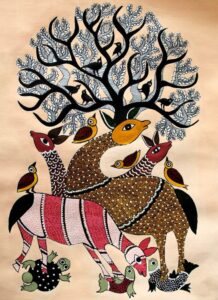
Full Information on Gond Art
Origin & Tribe
-
Community: Gond Tribe
-
Location: Predominantly Madhya Pradesh, also parts of Chhattisgarh, Odisha, Maharashtra, and Andhra Pradesh.
-
The term “Gond” is derived from the Dravidian word “Kond,” meaning green mountain.
-
The Gonds are one of the largest Adivasi communities in India, known for their deep connection with nature, music, and oral traditions.

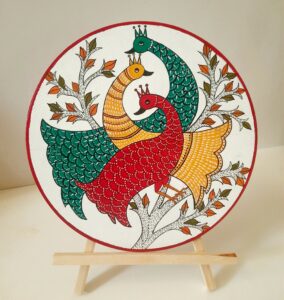
🎨 Characteristics of Gond Art
-
Technique: Fine dots and lines, bright natural colors.
-
Themes: Nature, animals, trees, festivals, daily village life, gods, and tribal mythology.
-
Mediums: Traditionally on walls using natural colors (charcoal, cow dung, leaves, and mud); now also on paper, canvas, and cloth.
-
Motifs: Deer, peacocks, tigers, elephants, trees of life, fish, and birds.
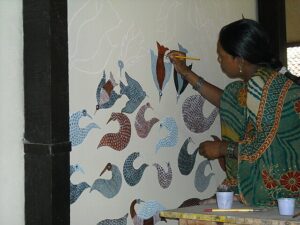
In modern times, Gond murals bring this ancient art into urban homes, cafes, offices, and galleries, creating a fusion of tribal heritage and contemporary design. Painted with intricate dots, lines, and bright colors, the murals often feature trees of life, birds, deer, tigers, and divine figures — each telling its own story.
Key Features of Gond Art on Wall:
-
Motifs: Tree of life, peacock, animals, tribal scenes, festivals, Ma Durga, or Lord Ganesha.
-
Technique: Hand-drawn with organic patterns using fine dots and lines to add movement and depth.
-
Mediums: Traditionally done with natural colors (charcoal, plant dyes), now often painted using acrylics or wall-safe paints.
-
Vibe: Rustic, earthy, cultural — adds warmth and storytelling to a space.
-
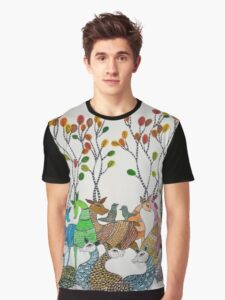
“Threads meet tradition — Gond art comes alive on fabric.” Full Information About Gond Art on Fabric
🧬 Origin
-
Community: Gond Tribe, one of India’s largest Indigenous communities.
-
Regions: Madhya Pradesh, Chhattisgarh, Odisha, and parts of Maharashtra.
-
Art Style Features
-
Technique: Traditionally hand-painted using natural dyes; now also done with acrylics and screen-printing for wearables.
-
Motifs: Tree of Life, peacocks, deer, elephants, tigers, birds, fish, tribal people, and deities like Ma Durga and Lord Ganesha.
-
Pattern: Fine dots, wavy lines, symmetrical patterns — filling the figure with texture and movement.
-
Color Palette: Bright reds, greens, yellows, blues, and black, often set against earthy or neutral fabric backgrounds.
-
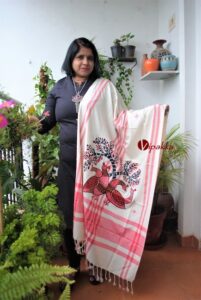
🖌️ Style Elements
-
Line Work: Repetitive, rhythmic lines and intricate dot patterns are used to infuse movement and texture.
-
Color Palette: Bright and earthy — typically red, yellow, white, green, and blue derived from natural sources.
-
Symbolism: Every element has a deeper meaning — e.g., a tree might represent a family or the divine connection with Earth.
Notable Artists
-
Jangarh Singh Shyam: A pioneering modern Gond artist who popularized the style beyond tribal regions and brought it to national and international art platforms. His work is known as “Jangarh Kalam.”
-
Other notable artists: Bhajju Shyam, Venkat Raman Singh Shyam, and Durga Bai Vyam.
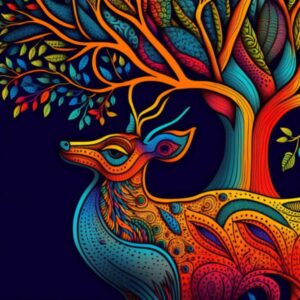
🏛️ Contemporary Significance
-
Gond art has transitioned from being ritualistic wall painting to contemporary fine art.
-
Now seen in galleries, museums, international exhibitions, and as part of eco-friendly design and home décor.
-
Used to preserve cultural stories, tribal identity, and as a medium of livelihood for tribal artists.
🌱 Cultural Importance
-
A sacred expression of the Gonds’ deep respect for nature.
-
Traditionally done during festivals and rituals, to mark celebrations or as a good omen.
